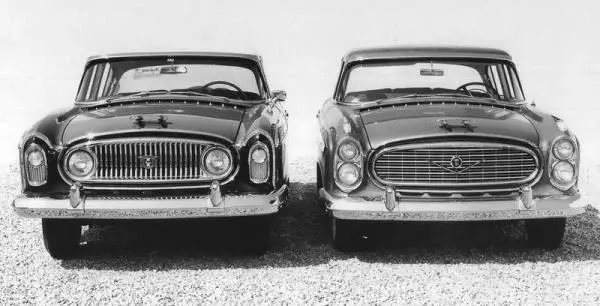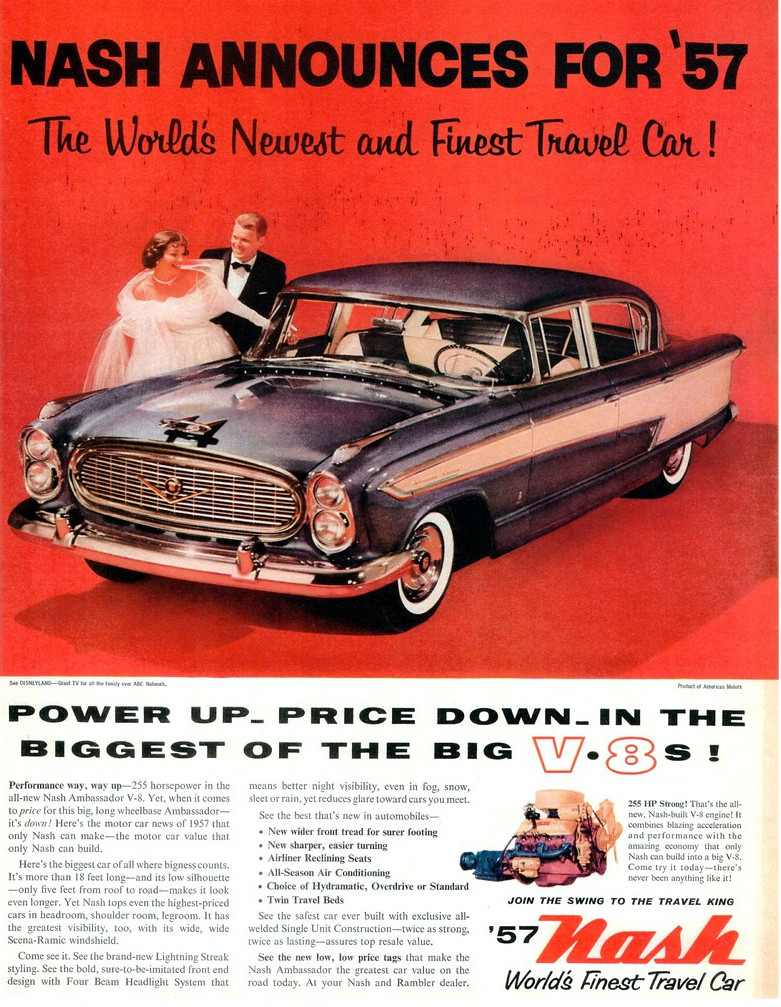By Robert Tate, Automotive Historian and Researcher
Images Courtesy of Chrysler Archives and the Robert Tate Collection
Published 12.6.2023
 The 1957 Nash Hudson assembly line in Kenosha, Wisconsin (Chrysler Archives)
The 1957 Nash Hudson assembly line in Kenosha, Wisconsin (Chrysler Archives)
The 1950s were a decade of space age automotive designs. For example, the 1957 Nash models offered a new and radical design when they were introduced to the public in September 1956.
The 1957 Nash Ambassador Custom models offered extra side trim for a three-toning color combination design. The styling for the Ambassador Custom was not thrilling, however, the car offered a luxury interior that some consumers liked. The 1957 Ambassador Custom two-door was offered as a hardtop model only with a 327 V8 engine, a four-barrel carburetor and dual exhausts as standard equipment.
 A 1956 and 1957 Nash front end comparison (Chrysler Archives)
A 1956 and 1957 Nash front end comparison (Chrysler Archives)
Patrick R. Foster, the author of “AMC Cars: 1954-1987 (An Illustrated History),” said: “For its final year on the market, the big Nash got revised styling including a lower roof, new front fenders with full wheel cutouts, and quad headlamps. Nash was the first car with four headlamps on all models."
 The 1957 Nash Ambassador Custom hardtop (Chrysler Archives)
The 1957 Nash Ambassador Custom hardtop (Chrysler Archives)
Consumer criticisms focused on the massive ovoid grille design and the side trim chrome styling that really stood out. Automotive historians also said the wraparound windshield design was too large. On the positive side, Nash interiors offered luxurious vinyls, along with fabrics and leather upholstery. The front seats also folded flat in case the driver or passengers need a snooze after driving for many hours.
 1957 Nash advertising (Robert Tate Collection)
1957 Nash advertising (Robert Tate Collection)
The advertising for the 1957 Nash models featured the slogan “The World’s Newest and Finest Travel Car!” The Walt Disney Company also promoted the 1957 Nash Ambassador, Hudson Hornet and Rambler during their television programs.
For many years, automotive historians have criticized the 1957 Nash models for their unattractiveness. One of the full-size models, the 1957 Nash Ambassador, had a price tag of $2,670 and proved to be unpopular. 1957 was also the final year for the Nash and Hudson nameplates after the merger that created the American Motors Corporation (AMC).
 A rare 1957 Nash ad (Robert Tate Collection)
A rare 1957 Nash ad (Robert Tate Collection)
According to automotive historians, George Romney (July 8,1907 - July 26.1995), who became AMC’s president after George A. Mason’s death in 1954, began to focus the company’s strategy and hopes for the future around building the smaller Rambler automobile. He requested that big cars be dropped from the brand lineup, after only 3,876 Hudson Hornets and 3,561 Nash Ambassadors were produced for the 1957 model year. The strategy actually paid off, as the Rambler became popular.
 A spread from a 1957 Nash sales catalog (Robert Tate Collection)
A spread from a 1957 Nash sales catalog (Robert Tate Collection)
The 1950s were a time of great domestic prosperity, and many of the automakers did very well from a sales standpoint. By 1957, the market was changing, and the independents started failing with the introduction of new Chevrolet and Ford models that began to dominate the US market.
Automotive historians for many years have said that, in 1957, Nash introduced these models at a time when chrome dominated automotive styling. The 1957 Nash models were the first American production automobiles designed with stacked quad headlamps, a design statement that would be copied by other American automakers in years to come.
 A 1957 Nash catalog (Robert Tate Collection)
A 1957 Nash catalog (Robert Tate Collection)
Finally, the 1957 Nash Ambassador models were vehicles that made an automotive statement. Today, these cars are mainly overlooked. By the early 1960s, rust and corrosion became a serious problem with Nash models. In terms of value today, a Nash in good condition might go for $30,000 at auction or if you could find one from a private collector. You might also find some on display in great automotive museums around the country.
 A 1957 Nash (Robert Tate Collection)
A 1957 Nash (Robert Tate Collection)
Bibliography
Foster, Patrick R. “AMC Cars: 1954-1987 (An Illustrated History).” Iconografix, 2004.
Consumer Guide. “1957 Cars.” Volume 162, November 1977.
American Motors Corporation. “American Motors Family Album.” First Edition, February 1969.
Litwin, Matt. “Picking Up the Pieces! 957 Nash Ambassador Custom Country Club.” Hemmings.com, September 23, 2018.



